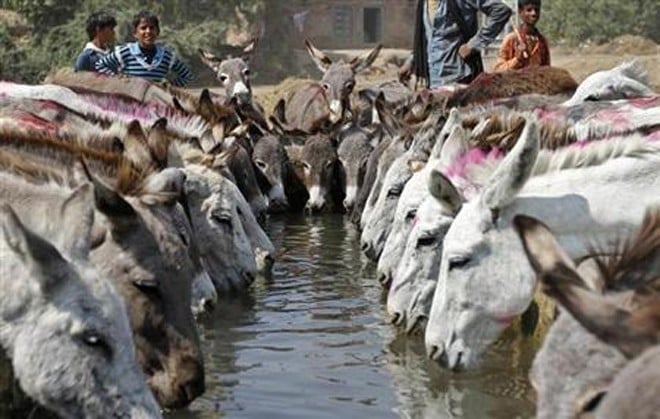
According to figures of the federal government, the number of donkeys has increased during the last one year in Pakistan

The total population of donkeys in the country has increased by 0.1 million, according to the Economic Survey of Pakistan for fiscal year 2014-2015. The number of donkeys in Pakistan increased to 5.0 million from 4.9 million. The survey also mentions that the population of camels, horses and mules remained unchanged since last year.
Nasim Sadiq, Secretary Livestock, Punjab, challenges the existing figures and claims that they have observed on the basis of surveys conducted by the livestock department, that equine (donkeys, horses, mules, etc,) population has plummeted by 70 per cent in the province since the last livestock census.
According to Pakistan Livestock Census 2006, there were 4.7 million donkeys, 0.34 million horses, and 0.16 million mules a couple of years ago. Ninety-five per cent of them are working donkeys.
The census said nearly half of the equine population could be found in the Punjab with 2.4 million animals, of which over 2.2 million are donkeys.
A table of PLC 2006 shows that among the traction animals, the population of donkeys was reportedly increasing faster than other types of animals.
The population of livestock varies from province to province. In provinces, the number of horses and donkeys increased at a faster rate in Punjab, sheep and camels in Balochistan, and mules in Khyber Pakhtunkhwa.
Read also: Editorial -- the donkey business
According to organizations working for the betterment of animals in Pakistan, donkeys, horses and mules provide vital support to the people by generating direct income for their owners, including women.
The Brooke Pakistan, an organization that delivers veterinary and welfare services to working equines, says that it is estimated that over 12 million marginalised people, directly and indirectly, depend on working animals for a living in Pakistan. Working donkeys also provide invaluable help to women who rely on them to lessen the burden of household chores.
Brooke Pakistan claims to reach over 500,000 horses, donkeys and mules across 32 districts in three provinces of Pakistan.
According to Brooke, "In Pakistan, the number of working equine animals is rising, while the standard of living for many people is falling. Over the past ten years, the population of mules has risen by 18 per cent, donkeys by 20 per cent and horses by 3 per cent.
Due to high petrol prices, poor communities use donkeys as economical means of transport. These animals, especially a donkey, play a key role in earning money for their owners and families.
According to Trends and Growth in Livestock Population in Sindh: A Comparison of Different Censuses, "In countries like Pakistan, 40 to 60 per cent of all goods taken to market are transported by animals, including camels, donkeys, buffaloes and oxen."